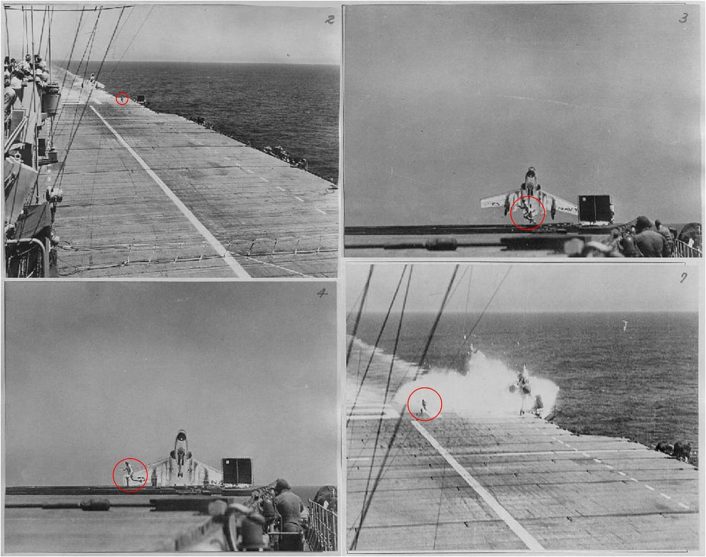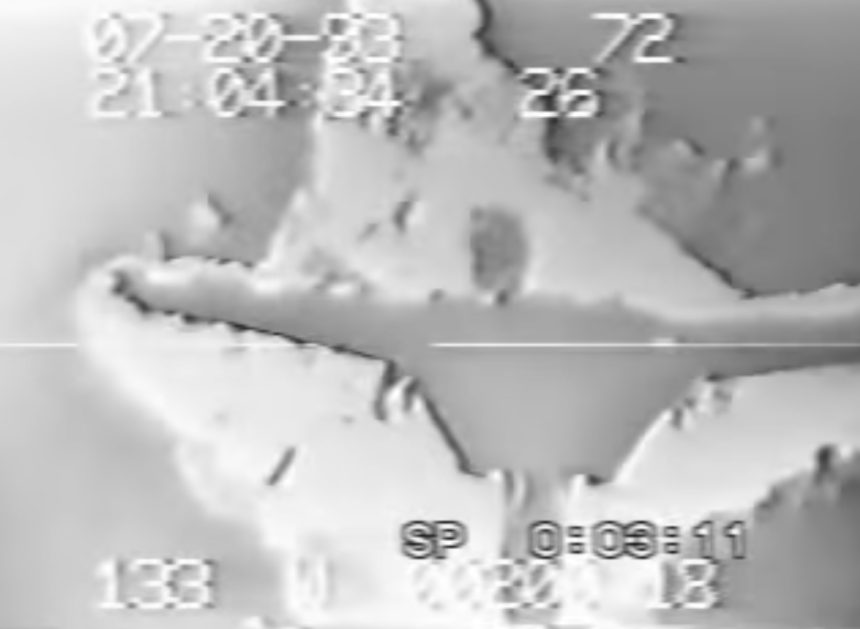Graphic footage shows the massive ramp strike of a Tomcat in 1993.
The footage below was filmed by the Pilot’s Landing Aid Television (PLAT) camera aboard Nimitz-class USS Abraham Lincoln (CVN-72), in the eastern Indian Ocean, on Jul. 20, 1993.
It shows the final seconds of an F-14A Tomcat, BuNo 159843 “NH-111”, belonging to VF-213, attempting to land aboard the flattop at night. The PLAT is used by Landing Signal Officers (LSO) to monitor approaching aircraft position on the glideslope and centerline.
In fact, from the last three quarters of a mile all the way to touchdown the pilots approaching an aircraft carrier can rely on LSO (radio callsign “Paddles”), skilled and experienced pilots whose job is to watch the deck-landing of all the aircraft and provide the pilots talkdown to adjust the final phase of the approach, complementing IFLOLS (Improved Fresnel Lens Optical Landing System) and ICLS (Instrumental Carrier Landing System) visual information. Instructions radioed to the pilots (that are extremely important to prevent the pilot from concentrating on the deck, thus not paying as much attention to the optical landing system) are concise: “Little low”, “Little right”, “Power”, “Wave off”, etc. “Paddles” job has very little to do with technology though and it mostly calls for a well-trained eye for the concise guidelines pilots are provided with over the radio are based almost only upon visual perceptions of the pilots who watch the in-coming traffic from the LSOs platform and suggest the various corrections according to aircraft’s landing and nav lights.
The PLAT footage on Jul. 20, 1993, shows “Lion 111”, piloted by Lt. Matthew T. Claar “Planet” with RIO Lt. Dean A. Fuller, first aircraft in the recovery cycle, dropping below the approach slope just before reaching fantail. The aircraft strikes the rear of the aircraft carrier (“ramp strike”) at 21:04:33: the rear fuselage explodes in a fireball and the forward section starts skidding along the flight deck trailing burning fuel.
Both crew ejected: the RIO survived as he was ejected into the water off the angle and recovered in a matter of a few minutes by a SAR helicopter. The pilot, Lt. Claar, who sequenced out first, ejected as the airframe was extremely nose-low, impacted on a parked aircraft on deck and died.
The clip includes radio communications.
The F-14 has started the final approach “slightly high[er]” than the glideslpe and “slightly right” than the centerline. As the aircraft approaches the fantail, the LSO radios “power! power!” shortly followed by “wave off! wave off! wave off! wave off!”. Unfortunately the pilot fails to correct in time.
All fires aboard the deck were extinguished and a ready deck was made available for all the recoveries in just 33 minutes.
Today, LSOs can also use a specially-provided radio-equipped emplacement fitted out with light controls, control workstation, Integrated Launch and Recovery Television Surveillance System (ILARTS) -that is a sort of camera aligned with the deck which catches and tapes any approaching plane. This system has eventually replaced the outdated Pilot Landing Aid Television (“PLAT”, on all carrier’s closed-circuit televisions).
A similar incident had occurred on Jun. 23, 1951, when Commander George Chamberlain Duncan, commanding Fighter Squadron 51 (VF-51), in the cockpit of a Grumman F9F-5 Panther BuNo 125228 hit the ramp during daylight approach to USS Midway (CVB-41) operating in the Atlantic Ocean off the Virginia Capes. Similarly to what happened four decades later to the F-14 of Lt. Claar, Duncan’s Panther dropped below the correct approach slope, struck the ramp and broke in half exploding in flames. The forward section slid down the deck. Duncan, though burned, was quickly rescued.
Footage from this ramp strike was used in several movies, including The Hunt for Red October.
Still, the most famous ramp strike occurred on Jul. 14, 1955, when a Vought F7U-3 Cutlass (BuNo 129595) of Fighter Squadron (VF-124) Stingrays suffered a ramp strike on landing aboard USS Hancock (CVA-19) during carrier qualifications off California. The pilot LCDR Jay Alkire, USNR, executive officer of VF-124, was killed when the airframe sank, still strapped into the ejection seat. Also killed were two boatswain’s mates and one photographers mate, in the port catwalk by burning fuel.










